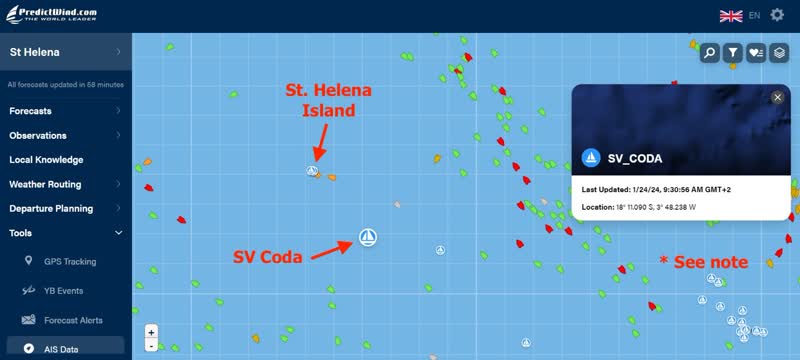We waited for an email giving us clearance to leave South Africa as calmly as we could. At about 9:30 a.m., it finally arrived. Wes then radioed both the harbormaster and the swinging bridge operator to request permission to leave the harbor. Permission was granted, and at first we thought we’d be able to leave quickly, but the swinging bridge operator decided to wait almost 25 minutes before opening the bridge to allow us and two other boats out of the East Quay.
It only took us about 20 minutes to make our way past the end of the breakwater and out into open ocean. While the harbor had some wind, there was very little on the open water, so we continued motoring northwest for awhile past Robben Island. We eventually found enough wind to raise the main and unfurl the genoa headsail.
A critical aspect of catamarans is that their mainsails have very little capacity to spill the wind if they are overpowered (unlike a monohull, which just heels over and/or rounds up to dump excess power in the mainsail). Coda‘s mainsail has three reef points in it, which allows four different “sizes” of mainsail.
Because winds were light, we raised the main completely. As the afternoon wore on, the wind continued to build, so we were obligated to begin adding reefs to the main, a process that involves three people (at least for a crew unfamiliar with it):
- One person to take in on the reef line on the front edge of the sail
- Another person to take in on the reef line on the trailing edge of the sail
- Someone to ease the mainsail halyard to slowly lower the sail.
- Someone to steer the boat (in this case, we have a very capable autopilot)
There are “lazy jacks” to guide the mainsail as it goes up and down, and there is a sail bag attached to the boom where the sail is stored and that keeps excess sail from flopping around when the main has reefs in it. Because the main has full battens in it, the process of lowering it through the lazy jacks and into the sail bag requires coordination and close attention.
Electric winches are used to haul in the reef lines, and the lines for the front edge reef lines are on the opposite side of the boat as the trailing edge reef lines. As the wind builds and the sails flap, a lot of hollering is involved in making a coordinated effort at lowering the sail.
Being near the coast, we seemed to be in a spot where the wind and the current combined to create very steep swells about 10 seconds apart. In order to get the mainsail down through the lazy jacks, the boat had to be pointed into the wind and the swell, which meant the bow was going up and down 12 to 15 feet every 10 seconds or so.
The lines were stiff from salt and lack of use which made all the hardware groan and pop, the wind was loud, the deck was pitching, and there were moments when it seemed like we were tearing the boat apart. But with much hollering and on-the-spot instruction from Wes, we managed to get three reefs in the main and the genoa partially furled just before sunset. Needless to say, if we had to have done a similar procedure in the dark, it might have gone much worse.
The boat settled down, and night came on, but none of us except Wes were used to the sounds of a catamaran going 12 knots across the water. The swell was behind us, so the stern would lift, the boat would accelerate from both gravity and the force of the wave, and the whole boat would rumble and shake as the crest of the swell passed between the two hulls. Waves would occassionally break against the hulls, making loud smacks or thumps. The most disconcerting sound was when a wave would crest under the boat and punch the underside of boat and send a jolt through the floor the main salon (if you feel a jolt in the floor of a monohull, it most likely means you’ve hit something or run aground).
The first night was a mostly sleepless one, and some of us later admitted that we went to bed wondering what we’d gotten ourselves into…

